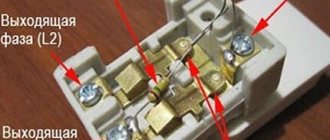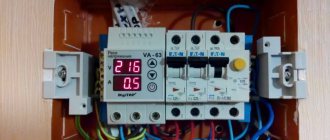To ensure a comfortable lifestyle, modern homes are increasingly using high-tech fixtures and appliances with a wide range of options. Such devices include smart switches that operate in automatic mode. It’s worth familiarizing yourself with the peculiarities of their work, don’t you agree?
The article we have proposed describes in detail the principle of operation and features of the use of smart switches, the operation of which is controlled remotely - using a tablet, smartphone, or computer. Advice on selection is given, and the specifics of labeling are discussed. The rating of the leading manufacturers in the segment is given.
Types of switches and the best manufacturers
At this time, the range of Wi-fi light switches is not very large. However, products are classified according to several criteria:
- The device can be adjusted with electronic or mechanical keys. In the first case we are talking about the touch screen of the device. The keys are on the remote control (remote control).
- There are also light switches with both dimmers and regular keypads. Using the first devices, you can adjust the brightness of the lighting, thereby changing its intensity. To adjust the brightness, either hold or scroll the corresponding button.
- This switch can provide full control of not only one, but also two or three groups of lighting devices. However, the price for a wireless device that can control entire groups is quite high.
There are currently seven main manufacturers of wireless electrical accessories for lighting control:
- Legrand - country of origin: France. The company has a whole line of products called Celian.
- Vitrum is a country of origin: Italy. This company uses a technology called Z-Wave. It allows you to fully automate the control of lighting in the house.
- Delumo - products are manufactured by a Russian company, which in particular produces dimmers, switches and thermostats.
- Noolite – accessories are made by Belarusian manufacturers.
- Livolo is manufactured in China. This company produces specialized devices for automation. The product line also includes products for both single and double frames for switches.
- Broadlink (China). This manufacturer has a fairly large selection of products for lighting control.
- Kopou is the latest company that is also based in China. The manufacturer produces dimmers in the form of various key fobs.
The video below provides an overview of another interesting model of Wi-fi light switch:
Top 7 manufacturers of smart devices
Switches capable of controlling light using a smartphone are produced by many domestic and foreign companies. Let's look at just a few of them that have received user recognition.
Legrand . A reputable French company founded in the first half of the 19th century. Specializing in the production of electrical equipment, the company produces a line of Celian wireless control devices.
Delumo . A popular Russian manufacturer whose product range includes a wide range of different types of switches, thermostats and dimmers. The products are in demand due to the optimal ratio of cost and quality.
Belkin. An American company that manufactures various types of wireless switches and other smart devices. All manufactured products are easy to install and comfortable to use.
Sonoff . The company specializes in the production of wireless smart devices such as sockets, switches, and relays. All equipment is offered with Russian-language instructions, as well as with specially developed applications, also made in Russian.
Vitrum . An Italian manufacturer that produces devices based on Z-Wave technology. As a rule, such devices are used in Smart Home systems to automate light adjustment.
Xiaomi _ A rapidly growing Chinese company founded in 2010. In addition to popular models of smartphones and tablets, the production facilities also produce high-tech electrical devices, including smart switches.
Noolite . A Belarusian company actively engaged in the development and sale of smart products, including dimmers, controllers, timers, switches, and protection modules. They are distinguished by reliability, ease of use, and low price.
Also worthy of attention are the budget but high-quality products of Chinese manufacturers Kopou, Broadlink, Livolo, as well as expensive products produced by the American company Lutron and the German company Jung.
Why do I need a smart home?
Automation makes your life easier and better in your home or apartment, moreover, it saves time and money. Here are a few reasons to start creating your smart home.
- Automation improves efficiency. This applies both to the efficiency of individual systems in your home and to the efficiency of the entire household. For example, because the automation system can control multiple devices, you can turn off thermostats and turn off lights with the touch of a button when you decide to go on vacation. You won't have to worry about forgetting to do something.
- Automation saves you money. Only smart control of lighting, heating, ventilation or air conditioning can reduce energy costs by 15-20%, according to automation system developers. For owners of their own homes, this also includes the opportunity to use non-standard heating or cooling systems, which also dramatically reduces electricity costs and allows them to quickly recoup their investments in a smart home.
- Automation is convenient. The ability to control many electronic devices (lights, heating, audio/video, curtains and doors, locks, security systems, etc.) using one touch device on the wall or just a smartphone - this alone makes you think about home automation.
- Automation creates comfort. The ability to actively control the various electronic elements of your home provides comfort in which the environment around you - from installing lighting to turning on the stereo - begins to obey you.
- Automation provides peace of mind. A home device control system allows you to avoid problems that may arise due to forgetfulness or inability. From anywhere you can check whether everything is normal in your home and, if necessary, make corrections using your smartphone.
Number of switches
Many can remember a situation where a huge chandelier hangs in the center of the ceiling of a large hall. As a rule, several light bulbs are installed on it, consuming enormous power to illuminate the entire room. However, it does not perform its task effectively enough, since the light is distributed unevenly throughout the room, but is concentrated as much as possible under its source. This problem is solved by mounting several lamps located at an even distance from each other. Moreover, you can enable them separately.
This practice leads to the need to install several or even about a dozen circuit breakers, which is obviously impractical. However, it is possible to replace the single with a double, which has been widely used for many years. Triple switches were the latest to appear and allowed three light sources to be controlled from one box.
They allow you to control electric lighting quite comfortably. However, many people like it when control of this process is as simple as possible (and even better, when shutdown can be done remotely). Actually, manufacturers offer several solutions for this purpose in the form of smart light switches, which will be discussed below.
Principle of operation
The principle of operation is quite simple: the remote switch connects to the Wi-Fi router via an encrypted signal, and the device receives a unique IP address. It is most convenient to store ready-made lighting control scenarios on the server, because if the connection is lost, the settings stored inside the device are automatically canceled, and then there will be a need to enter them again.
The electrical impulse generated by the wireless switch generator, when a command is given from the control panel, is converted into a signal that enters the device and gives a command to turn the lighting on or off or to play a preset scenario.
I am smart Ya-T3W
- Voice assistant: Yandex Alice, Google Assistant, Amazon Alexa
- Wireless: Wi-Fi 2.4 GHz, 802.11 b/g/n
- Number of keys: 3 pcs.
- Dimensions (width × height × depth, mm): 85 × 85 × 35
Price: from 1,490 rubles
I Smart Ya-T3W looks like Aqara is nervously smoking on the sidelines. This is a three-channel wall touch switch, the surface of which is covered with glass. It runs on Wi-Fi, so the owner can control it directly from his smartphone or through one of the smart speakers. In addition to Alice, Ya Smart Ya-T3W is also friends with Alexa and Google Assistant.
Despite the unique futuristic design, the price of the gadget is very affordable - only one and a half thousand for 3 channels.
Connection diagram
The connection process consists of 2 steps: the first is installing the receiver, and the second is installing the control button (switch).
The receiver is usually equipped with 2-4 wires that come out of its housing. The instructions will detail which of these wires is the input. Others are outputs (for example, in a double switch there will be 2 outputs). To install the receiver, you will need to open the phase supplying power to the lighting device and connect it to the circuit, observing the sequence.
Connecting a wireless light switch
If you have more than one light group:
- apply zero to all lighting;
- split the phase in the Wi-Fi device;
- supply the phase separately to each group with lighting fixtures.
The switch (control button) is also extremely easy to install: drill a hole in the wall. Place a regular plastic socket box in it. Next, the installation process repeats the installation of a conventional switch. You don't need to install any wiring - just fix the button in the box.
Yeelight Smart Switch Light three-key
- Wireless: Wi-Fi 2.4 GHz, 802.11 b/g/n
- Number of keys: 3 pcs.
- Dimensions (width × height × depth, mm): 86 × 86 × 32
Price: from 700 rubles
Looking at the Yeelight Smart Switch Light gadget in comparison with the Aqara switch from Xiaomi, you can’t help but wonder: where’s the catch? Why is the three-key gadget from Yeelight 3 times cheaper than the two-key Aqara - despite the fact that it looks no worse? We can only assume that Xiaomi is making such a big deal about the brand.
Yeelight Smart Switch Light is made of fire-retardant polycarbonate, so it can withstand very high temperatures. The contacts are made of silver, which hardly oxidizes and does not spark. The switch keys are designed for 40,000 clicks. Let us note an interesting feature of the gadget – the presence of an external toggle switch to turn off the power.
How to make everything work locally
Here we come to the limit of our beloved HomeBridge system. To develop a smart home further, you will have to move up a level and set up a full-fledged alternative system for controlling gadgets in the house.
There are quite a few alternatives, but their main advantage is independence from external servers, Chinese clouds or smartphones/tablets/computers used.
To do this, there must be a server with a similar system at home or a specialized gadget that will serve as a hub. Unfortunately, not all devices can be connected, because this requires the so-called developer mode, which allows gadgets to work with alternative systems.
Almost all of our favorite Xiaomi devices have this mode, which means that the scope for experimentation is limited solely by our imagination.
I invite those who are a little in the know to vote for the management system they are most interested in, so that in the future we can begin to build and develop it.
iPhones.ru
And will anything even work?
Woopower
Most craftsmen turn to Chinese manufacturers to independently create a smart home, mainly through popular trading platforms - wholesale and retail. In many ways, this is a lottery, especially if you take no-name collected by no one knows who, where and without any guarantees. However, based on consumer reviews, certain conclusions can often be drawn.
Features, characteristics and operating principle of a smart socket
In combination with the multifunctional gateway, which was described above, a smart socket allows you to check the status of a particular device even in the absence of the owner of the house.
Through a special application, you can set the on and off time for each outlet. To distinguish connected devices, special icons can be installed.
Smart plug characteristics:
- Wi-Fi support;
- Load - 2.2 kW;
- Voltage - up to 250 Volts;
- The body has a square shape;
- White color;
- Weight - 63.5 grams;
- Dimensions - 5.5*4.4*3.1 cm;
- Operating temperature - from 0 to 40 degrees Celsius.
Possibilities:
- Remote control from a smartphone. The user can set any scenario for the socket. For example, at a certain time the water heater, the light in the hallway or the multicooker turns on.
- Automatic shutdown when overheating (temperature sensor provided). If the outlet becomes overheated, the user receives a corresponding notification and the current supply is stopped.
- Check status from a distance. Now you don’t have to worry about devices that are not turned off.
- Timer function. Using this option, it is possible to reduce energy consumption and extend the life of various devices. For example, you can set the water heater to turn on and off before waking up or coming home from work.
- Application of complex technologies in production. In the manufacture of the device, fire-resistant material is used that can withstand temperatures up to 750 degrees Celsius. Product quality meets CQC standards.
- Compatible with Android and iOS operating systems.
Connecting the smart socket of the Xiaomi Smart Home kit occurs in three steps:
- As soon as the indicator starts flashing yellow with increased frequency, you need to launch the application, then click on “+” to add a device.
- Select a wireless network, enter your username and password.
- If the indicator lights up blue, the device is ready for use.
Increase the intelligence of your home: smart light switches
In some ways, not much has changed with smart switches. You will still be able to control them from the wall as always.
The upside of smart switches is the added functionality you'll love. Some come with remote controls that make manual operation easier, and you can also dim the lights when the mood calls for it.
Another key benefit is that smart switches work effectively with existing fixtures, even if they are not suitable for a smart bulb.
Installation is permanent and more complex, but the results are worth the extra effort.
Xiaomi ecosystem
The range of various devices in this ecosystem is very large. Globally, gadgets can be divided into three groups, depending on the communication protocol: Wi-Fi, Bluetooth or ZigBee.
Wi-Fi and Bluetooth devices operate independently and connect directly to the smartphone that controls them (or through a hub device, as is the case with Bluetooth). So, if you have Wi-Fi, even without the Internet or within Bluetooth range, you can control most smart gadgets in the house.
ZigBee devices operate through a special hub, which in turn connects to the home Wi-Fi network. Without the Internet, but with a connection between the hub and the smartphone, you can control ZigBee devices.
Things are a little more complicated with automation scripts. Some of them are stored locally on devices or in a hub, and some are uploaded to the Chinese cloud.
Any scenario is easy to test. To do this, go to the Mi Home application, open the Automation tab and click on the script.
Now go to settings (the button with three dots in the upper right corner) and see the operating mode of this scenario.
Scenarios that link devices in the house without external factors (time, weather, geolocation) are most often stored locally. Most scripts for ZigBee devices will be stored in the hub's memory.
Scenarios with notifications for a smartphone or data transfer to the network (for example, uploading photos or videos from a camera) will go to the cloud.
In addition, most smart gadgets have built-in memory for storing trigger timers. If you set the lamp to turn on in the evenings at a certain time, set the parameters for the socket or switch, they will work obediently even without the Internet.
When you transfer gadgets to HomeKit, most of the features will remain.
Unfortunately, without the Internet it will not be possible to create a new automation script; the list is stored in the cloud and loaded from there each time.
Conclusion: although the ecosystem of Xiaomi gadgets is criticized for being tied to Chinese clouds and servers, developers are trying in every possible way to organize local interaction between gadgets.
It’s nice that you can go through already created scripts yourself and see where they are stored. If necessary, you can try to reconfigure them to work locally by removing the notification on your smartphone when triggered or by linking them to the local time on the device instead of sunset and sunrise time.
Protocol: Z-Wave or Zigbee?
As with all aspects of your smart home, there is never one clear path that is best, just a case of what works best for your situation.
If you're only interested in a smart lock, a few simple smart bulbs, and maybe a speaker, you won't run into many issues with communication standards.
On the other hand, if your smart home includes garage door automation, smart switches, and other layers of smart home security, you'll likely encounter Z-Wave and Zigbee.
Simply put, Z-Wave and Zigbee are radio protocols that call a third-party hub to allow your smart devices to communicate with your mobile phone. Bluetooth and Wi-Fi enabled devices, on the other hand, can communicate directly without the need for translation.
While Z-Wave and Zigbee are not directly compatible with each other, you can bridge this protocol gap with hubs and smart speakers, so it becomes less of a contentious issue.
Review and capabilities of the main gateway (controller) Xiaomi Smart Home Gateway 2
The controller combines the elements of the Smart Home system into a single whole. Its functions include connecting sensors, setting control programs, sending commands to connected devices, and working as a night light or radio.
The kit comes with an instruction manual, the controller itself and a special clip. The latter is necessary to link regulatory authorities to the device.
You can judge the quality and reliability of the controller just by its appearance. But keep in mind that its plug is only suitable for Chinese sockets, so you will have to purchase an adapter.
Gateway versions
The Xiaomi Smart Home controller has a second version gateway. The first version does not have a radio, and the second version has a radio.
The advantage of the latter option is that the device works in developer mode and copes well with tasks in alternative control systems.
The diameter of the controller is about 8 cm and the thickness is 3.5 cm. The product has a button that, when pressed, activates additional functions.
A speaker is installed on the front part. It is necessary to work in radio, alarm or alarm mode.
Features of the Zig Bee interface
The controller’s task, in addition to the functions already discussed, is to combine two interfaces - Wi-Fi and ZigBee.
The ZigBee interface has much in common with a wireless network and “blue tooth”, but it has a feature - it consumes a minimum of electricity, which ensures a battery life of up to a year or more.
To receive signals, a gateway and ZigBee protocol are used. As soon as a signal is received by the device, the controller communicates with a special “cloud” using the interface, after which certain commands are executed.
If you disable the gateway, all sensors that are connected to it are also deactivated.
How is a mesh built using the ZigBee protocol?
Setting up the Xiaomi Smart Home network is as follows:
- Plug the controller into a power outlet. Make sure that the mains voltage meets the required parameters. The device begins to blink yellow, beeps and greets with a voice. There is a special button on the case, pressing which resets to factory settings.
- Download and install the MiHome application. The box contains a link to the original application, which is not translated into Russian. This is the main disadvantage of the Xiaomi Smart Home.
- When a new device is connected, the program automatically detects it and signals the owner about the need to add it. To do this, click on the “+” button in the upper right corner.
- Enter your Wi-Fi login and password and click “Next”. If all operations are completed without errors, the device is connected.
- Specify the room where the product is installed and confirm the action.
READ ON THE TOPIC: CLAP smart home - a look from the inside.
To control the controller, log into it through the app on your phone. The user can turn on the backlight, change the color and brightness of the glow.
When you go to the Device tab, you can add new sensors. To do this, click “Add device”, select the device and click the confirm button (located at the top).
Neutral wire/C wire
Before you start, you need to understand your home wiring.
Most regular switches and sockets use 2 wires:
- Live
- Neutral
IoT devices, like most electronic gadgets, operate on low voltage DC power.
If you want to add smart light switches, you will need at least one more wire to connect to a DC power source. This is called a common wire or C-wire, and it allows you to send a signal to any of your IoT devices.
Unfortunately, approximately 50% of North American homes do not have this C wire, so how can you get around it to achieve your smart lighting goals?
- Choose smart switches that don't require an extra neutral wire
- Add wires to existing wiring, but this is expensive and creates a real mess. This is the best method if you are renovating and the wiring is already exposed.
- Smart bulbs eliminate any wiring hassles and give you bulb-level control
- Choose smart LED lights with battery-operated switches
Once you've solved your wiring problem, you need to think about which communication protocol is best for your smart home.
Advantages and disadvantages
The advantages of Wi-Fi switches include:
Ability to configure the required operating mode or lighting option in different rooms; The device works with all types of lamps; during installation, there is no need to change the entire lighting system; The signal covers a fairly large surface and easily penetrates all obstacles and walls; No need to lay cable
This includes several advantages at once: no need to damage the walls in the process of laying the wire, no need to choose a place for the switch (a Wi-Fi switch can be installed anywhere, for example, on a cabinet or table), no installation errors (especially important in wooden houses that can easily catch fire); If the device is damaged, the electric shock is small and will not harm the owner; By downloading the application to your phone, you can control the network from anywhere, sometimes even from the street (some switches operate at a distance of up to 350 meters from the point); Touch models are silent - parents of light sleepers will find it convenient to turn off the lights.
The device has practically no disadvantages. Mainly noted:
- Higher price compared to conventional lamp connection options;
- When placing the device near metal structures, signal interruptions may occur.
Smart Appliances: Pros and Cons
Devices that can be controlled using smartphones have undeniable advantages:
- to install them, you do not need to lay a special dedicated branch of electrical wiring;
- they allow you to regulate the operation of light sources, as well as other devices, centrally from one place;
- smartphones, tablets, computers, as well as remote controls can be used as a control point;
- smart devices contribute to a significant reduction in energy costs - according to calculations by American scientists, savings can reach 42%;
- the devices have a wide range of action (up to 100 meters), while the signal passes freely through various obstacles, for example, walls;
- for their operation, a weak current is sufficient, which will not harm a person even if the system is damaged.
The main disadvantage of smart switches is the need for an Internet source.
For user convenience, a number of models are equipped with an additional radio control function. This allows you to use them even in case of difficulties with access to the World Wide Web
Purpose
A WiFi switch is a special device that allows you to control the light: turn it on or off, adjust the power or set a timer. There is no need to go to the switch on the wall: control is carried out from a configured smartphone.
This control system is extremely convenient and useful. For example, if you need to dim the light while lying in bed, control the lighting in the next room (for example, in a nursery), or turn off a forgotten lamp when leaving the house.
Important! To control over the network, you need to install the built-in module on your home network and download the application to your smartphone
The WiFi switch can receive signals through walls and furniture, that is, from any part of the house.
PS-Link WF-ED
- Voice assistant: Amazon Alexa, Google Assistant
- Wireless: Wi-Fi: IEEE 802.11 b/n/g 2.4 GHz
- Number of keys: 1 pc.
- Dimensions (width × height × depth, mm): 86 × 86 × 33
Price: from 1,550 rubles
Ps-Link WF-ED is a smart switch with a dimmer, that is, it can adjust the brightness of the lighting. The brightness can be controlled either from a mobile phone through the Tuya application, or by pressing the keys on the switch itself (+ / -). However, you can only adjust lighting via a smartphone if the load is within 400 W.
The disadvantages of the device are the need to connect to the neutral wire, as well as the rather high price for a no-name device. You have to pay extra for a dimmer.
How to install Xiaomi/Aqara switches
The described nimble switch models have one serious drawback - the square shape of the intravenous block.
The switch will not fit into our usual round socket box. At the stage of construction or major repairs, it is enough to purchase special square boxes in which such switches are perfectly installed, and replace the original round ones with them.
It is difficult to fit such a switch without noise and dust into a room with a completed renovation. There are special external boxes that hide the insides of square switches outside the wall.
The appearance is so-so, the thickness of the box with the switch is about 4 cm. My wife will definitely not praise this decision.
This is how you need to enlarge the hole in the wall
All that remains is to widen the existing hole in the wall from the round socket box so that the square switch fits into it.
It all depends on the material of the walls. Plasterboard walls can be easily cut to the required size, but brick or concrete walls will have to be chiseled.
In most cases, you can do a little work with a hammer and chisel, but sometimes you will have to resort to using a hammer drill.
15 minutes of work and a round hole in the wall turns into a square one.
The rest is a matter of technique. We connect the breaking phase to terminals L and L1 (for a two-button one, also to L2), and if there is a zero line, we connect it to terminal N.
We pair the switch with the gateway via the Xiaomi Mi Home application (iOS, Android) and it immediately appears in the Home application.
Unfortunately, you cannot use your voice to set the shutdown or timer shutdown
All! You can control the lights in the room from your iPhone, using a voice assistant, or in the Home app on iOS.
iPhones.ru
Let's consider all possible options.
Digital Assistants: Compatibility
If you're already using Alexa, Siri, or Google Assistant, check and make sure the smart light switches you're considering are compatible with your favorite digital butler.
Once you've gotten used to barking commands like "Turn off all lights" as you walk out the door, or once your lighting has become fully assimilated into your morning routine, you'll fully appreciate the simple convenience of controlling your lighting using your cell phone or voice activation.
Interaction with other devices
The autonomy of a smart device depends on its design features. Wi-Fi devices can work directly from a smartphone without the use of any additional devices.
When connecting a smart switch, it is advisable to use fairly deep socket boxes. This will allow you to conveniently lay all the connected wires and the device itself.
At the same time, to regulate the operation of devices operating on the ZigBee or Z-Wave protocols, an additional product is required - a controller, which acts as an intermediary between the switch and the smartphone.
The same control device is also used to store user programs, for example, information about the time of automatic switching on/off of lamps. At the right moment, the controller transmits the necessary signals to the lighting fixtures, which guarantees the execution of the specified algorithms.
With the help of modern technologies, it is possible to establish an interoperable network consisting of a number of smart devices. The consumer has the opportunity to set the switch to turn on the light based on a signal from a sensor that is triggered when the doors are opened.
In turn, turning on the lighting in the room can affect the start of operation of other household appliances, for example, an air conditioner.
Using smart devices
Smart switches provide homeowners with many new options. With their help, you can adjust the light parameters in the room using your smartphone. A very convenient feature is programming devices to automatically turn on/off at a certain time.
In addition, the homeowner can check from a distance whether the lights are on in a particular room, and, if necessary, remotely turn off any of the lamps.
Another option: the mode of turning on the lighting in the room as soon as a person enters it and turning off the light when the owner or guest leaves.
There are switches designed to provide control over one or more groups of light sources located in different rooms. The cost of multi-channel models is significantly higher than single-channel ones
An option that allows you to automatically light the lamps when it gets dark and turn them off when there is enough sunlight allows you to significantly reduce your electricity costs. Some models also provide a function for monitoring the use of electricity.
Smart devices with dimmers provide even greater possibilities. They are designed not only to turn on/off lighting fixtures, but also to change the level of lighting intensity.
Such smart devices allow you to change the brightness of the lamps according to a given program or taking into account data received from light and motion sensors.
How to choose?
There is not a very wide variety of wireless lighting control devices available in stores and on selling websites, but different models offer different functions, taking into account the needs of the most demanding customers.
When choosing a Wi-Fi switch, you should pay attention to the following points:
- purpose (light control inside or outside the house);
- technical characteristics (power consumption, operating signal frequency, coverage area, device power type, temperature range of uninterrupted operation);
- number of keys (it is better to determine in advance exactly how many devices need to be configured for remote control);
- the ability to leave 1 or 2 keys to work in normal mode by pressing with your fingers, without programming, and program only 1 key;
- design (mostly white switches with rectangular plastic keys are produced, but round models are also available for sale).
Conclusions and useful video on the topic
In the presented video you can hear a detailed overview of the popular model of Wi-Fi switch manufactured by Soniff. Visual instructions for connecting this device are also provided:
Smart appliances can significantly improve the comfort level of residential premises. They are also important for providing the owners of apartments or houses. The devices will automatically turn on the lights and can scare away criminals from an empty apartment, simulating the presence of the owners.
Please leave comments in the block below, ask questions, post photos on the topic of the article. Tell us about how you chose a smart switch. Share the criteria that were decisive in determining the best model for you.
Design features
The Wi-Fi switch kit includes a receiver and transmitter. The receiver is a control relay. You can control it via a smartphone with access to a Wi-Fi network, or using the remote control. When the relay receives a certain signal, it closes the electrical circuit. The relay is installed near or inside the lamp. This is possible due to the small dimensions of the device. The reason for installing the device near the lamp is so that it does not fall out of the radius in which the transmitter operates. If the room has spot lighting, the receiver can be placed in a distribution box or behind a suspended ceiling.
The switch or transmitter has a small power generator that is capable of generating electricity when you press a button on the remote control or send a specific command from a smartphone via a Wi-Fi connection. In turn, the pulse is processed into a radio signal, which enters the device. Such radio-controlled light switches are quite expensive, and their analogue is control from a remote control that contains batteries.
Labeling of smart devices
Smart switches often have letters and numbers printed on them to indicate their characteristics. Please note that different manufacturers often use their own labeling, so the designations may not be the same.
Nevertheless, we will name a few typical options. First of all, the name of the devices may mention the control method, for example, Wi-Fi. In hybrid solutions that can be controlled using a radio signal, the designation Wi-Fi/R or Wi-Fi/RF is used.
To facilitate the wiring diagram, instructions can be marked on the device box. Phase conductors are marked with the letters L and L1, zero conductors are designated as N, and protective conductors are marked with the combination PE
The two-digit number located at the end of the model name - 01, 02, 03 - indicates the number of light groups that can be controlled from this device.
The device marking may also contain the following letters:
- S – with pass-through switch function;
- D – allows you to dim the lighting;
- T – the presence of a timer that allows you to turn on/off the light at a given time.
Often, an indicator is also placed on the device indicating the degree of protection from moisture and dust. It consists of a combination of the letters IP, followed by a two-digit number.
Its first digit in the range 0-6 indicates the level that prevents dust and foreign objects from penetrating into the product. The second, in the range of 0-8, indicates resistance to water vapor. The higher the numbers indicated, the higher the degree of protection.
The following signs are also placed on any device: I or In, meaning switching on; O or Out – turn off the device.
What interesting things are there in the Sonoff assortment?
For home automation we recommend the following devices:
■ Smart Wi-Fi relay for 10A – 461 rub. per piece or 385 rub. per relay when buying 5 pieces.
Installs into the cable gap of any device and makes it smart. You can connect ventilation, lighting, power a room or a separate outlet for quick shutdown.
■ Wi-Fi relay 10A with temperature and leakage sensor – from 663 rub.
The relay can operate under various conditions depending on the readings from the sensors.
■ Wi-Fi relay for 16A – from 778 rub. Can be equipped with sensors.
This thing helps automate heating boilers by changing their settings based on the temperature of the air or water in the system.
■ Smart Wi-Fi socket – from 795 rub. (there are models with different forks).
We install the module into a socket and control any connected device.
■ Wi-Fi relay with four channels – RUB 1,705.
Distribution block for separate switching off of lights in rooms or for phase separation within one room. You can connect a radio remote control.
■ Smart Wi-Fi cartridge – from 729 rub.
Installed in a lamp or chandelier for remote control of the light bulb.
■ RGB light bulb with Wi-Fi module – RUB 1,056.
Scenarios, color and brightness of the glow can be adjusted.
■ One-button smart Wi-Fi switch RUB 829.
It is installed to replace the standard one and is controlled from a smartphone within a Wi-Fi network.
■ 1-, 2-, 3-button radio switches – from 1195.
They operate at a frequency of 433 MHz and require a special hub to control via Wi-Fi.
■ Hub for controlling radio devices via Wi-Fi – RUB 829.
Unites all nearby devices that operate at 433 MHz and allows you to connect them with other gadgets within your home network.
■ Wi-Fi LED strip – from RUB 1,759.
RGB tape in 2 or 5 meter versions.
As you can see, the prices are really reasonable. This is one of the most affordable automation systems for a smart home; in some niches, the devices even outperform Xiaomi gadgets.
Several popular models
There are a lot of ready-made model kits. Among them there are both simple and budget solutions, as well as more complex systems for the comprehensive arrangement of a smart home.
Feron TM75
One of the simplest and most budget-friendly types. The kit contains the main unit and control panel. The device is designed to operate on a 220 V network and for a maximum load of 1000 W.
A simple and convenient wireless switch for your first acquaintance with technology
Operating temperature can vary from -10ºС to +40ºС. There are two channels available for connection. Among the features we can highlight the possibility of switching on with a delay. The remote control is powered by one A23 battery.
Inted 220V
Another fairly simple option for installing a wireless switch. The kit includes the switch itself with 3 buttons, which is mounted on the wall, as well as 3 control units to which the signal from the switch is transmitted.
The design is simple and unobtrusive
Thus, the kit consists of three channels to which three series of devices can be independently connected independently of each other.
Inted-1CH
Single-channel version of the wireless switch from Inted with remote control.
A simple single-channel switch for one device or a series of similar ones
Capable of operating in 220 V networks. The receiver can operate in 3 different modes: by pressing one button, by pressing two buttons, and by holding down a button.
Sapphire-2503
Interesting development. It is a regular switch that can be controlled either physically or using any TV remote control.
Combined option - both a simple switch and a wireless one
You can turn on the light manually if you are near the switch, and from the sofa you can control it using the TV remote control. In addition to the main function, it can simulate the presence of a person in the room by randomly turning the light on and off.
HiTE PRO
This is not a separate model of wireless switches, but a line of components from which you can assemble a wireless device control system for almost any need.
Using various gadgets from the HiTE PRO series, you can assemble a system of wireless switches
Control units, stationary switches or autonomous control panels are purchased separately. We can say that this is not the most budget option. The cost of a simple switch alone can reach up to 1,500 rubles. But the series has a large signal transmission radius (up to 250 meters), a good temperature range and compatibility with other similar brands.
Types of smart units
Manufacturers offer a fairly wide range of smart solutions that can work on Wi-Fi, Bluetooth, ZigBee, Z-Wave.
The devices also differ in design features. Some of them are specifically designed for connection to a network in which a neutral wire is present. At the same time, phase “0” is not required for installation of many products, including most smart dimmers.
Devices with dimming function
A significant part of the models of smart devices for turning on/off lights also successfully play the role of a dimmer - a device that regulates the brightness of lighting fixtures. All options in this case are preserved: the smart device, controlled from a smartphone, can operate in automatic mode.
The control module, that is, a device without a key, can be installed in a socket box and used as a regular socket. In this case, the device acquires all the above-mentioned options of a smart device - remote control, programming, automatic operation
Additional capabilities provided by dimmers allow you to significantly expand the range of use of switches.
With their help, it is easy to create a cozy atmosphere in the room, turning on bright light only when necessary. In addition, dimmers are also widely used by interior designers as lighting control devices.
Devices with remote control
Another type of smart device is a remote switch. In appearance it resembles a traditional one, but in fact it is a remote control.
A number of domestic and foreign manufacturers produce keypad models of smart devices that are installed in sockets instead of traditional switches
An intelligent device, like a regular switch, consists of a frame and a key. Since it does not require any electrical wiring, it can be installed almost anywhere in the room.
The function of the remote switch is to transmit commands via radio waves to other devices. It necessarily works in conjunction with other devices, for example, together with a dimming switch, which, after receiving a signal, will reduce the light intensity in a burning chandelier.
The same device can also be used to control the operation of a smart socket.











